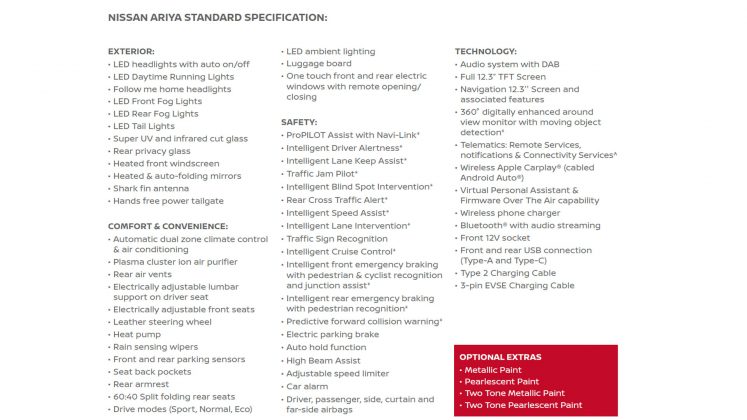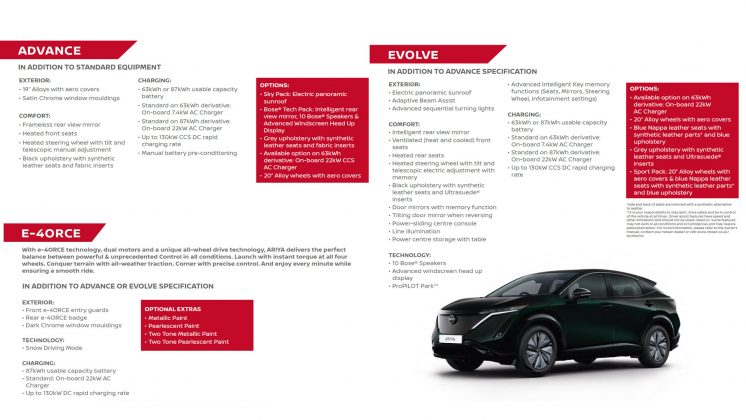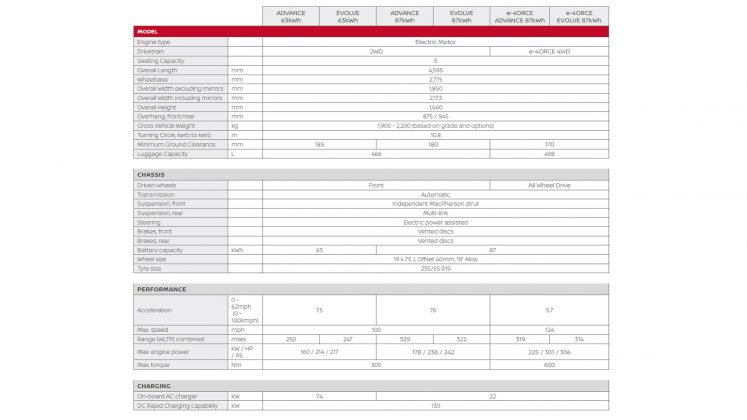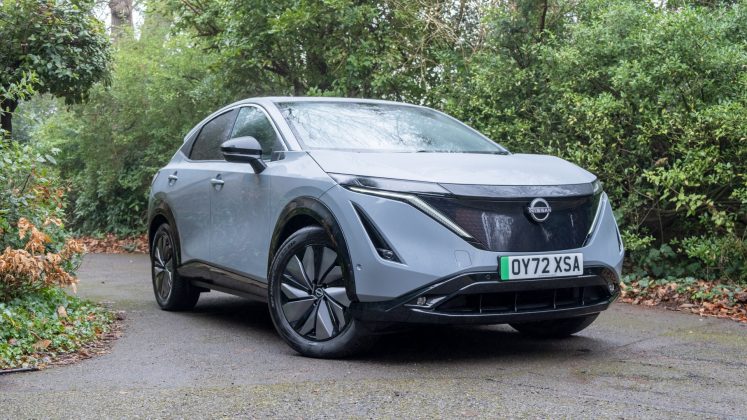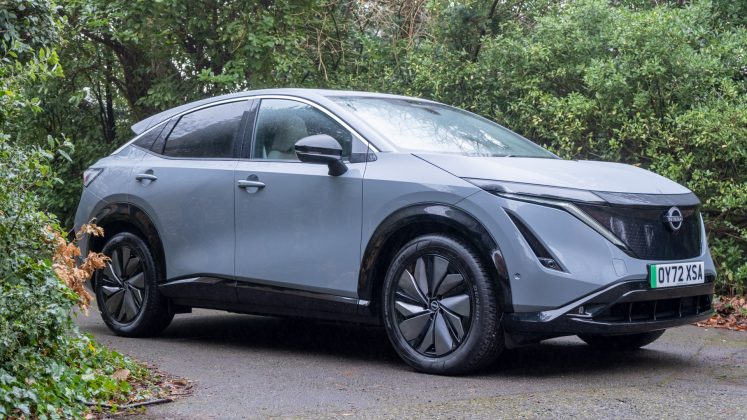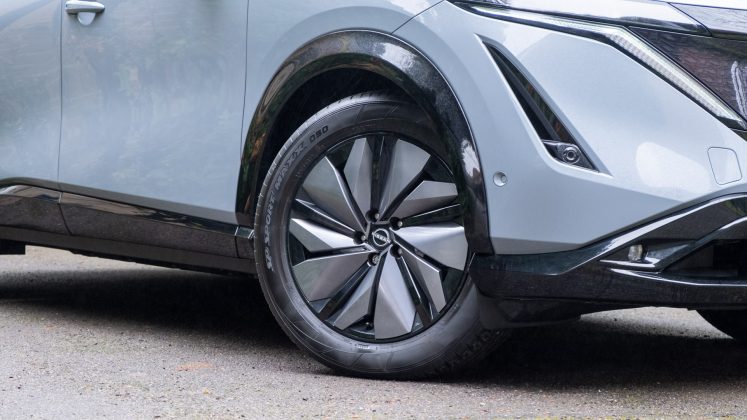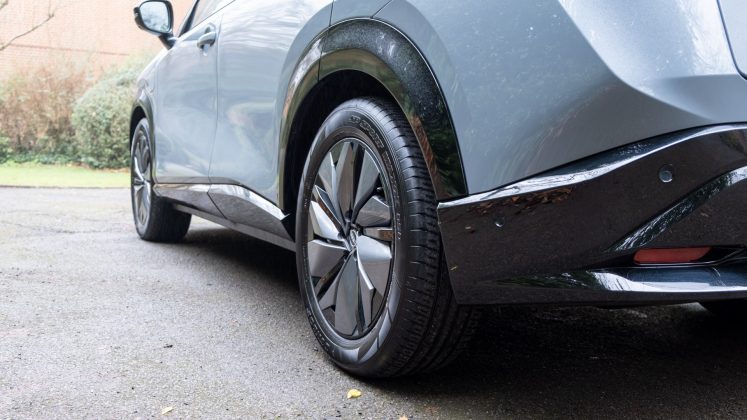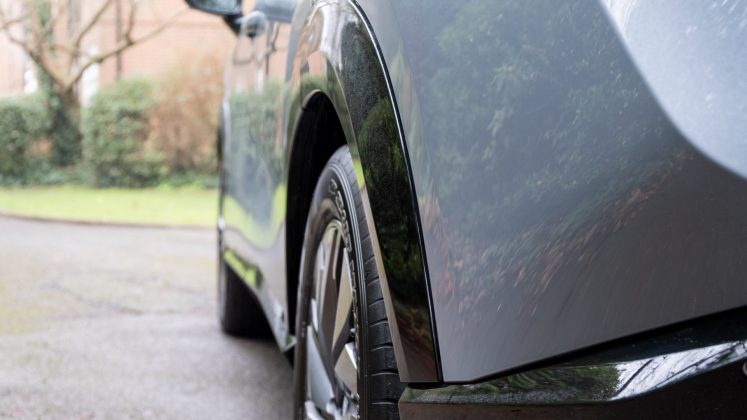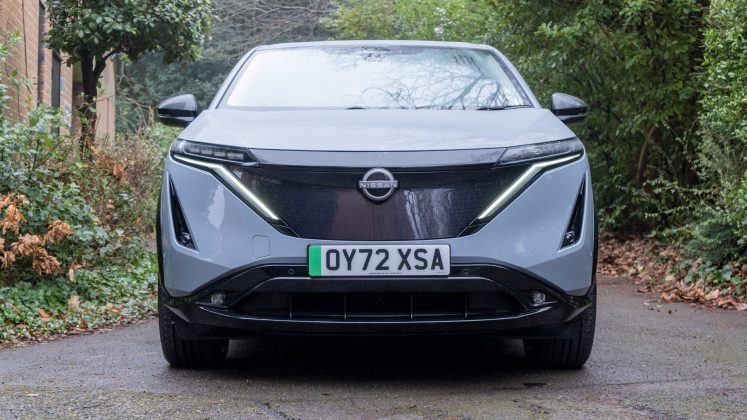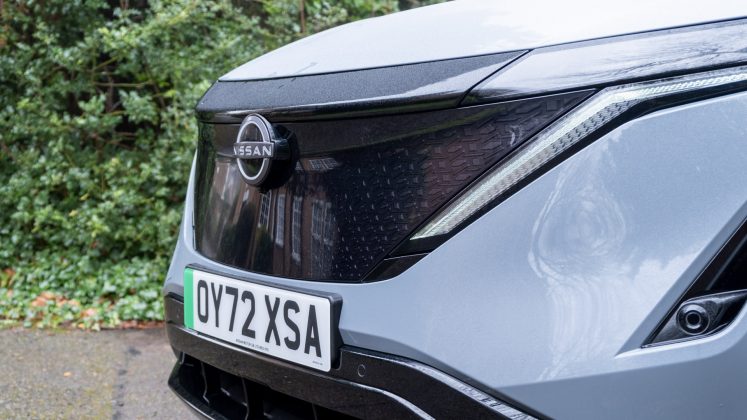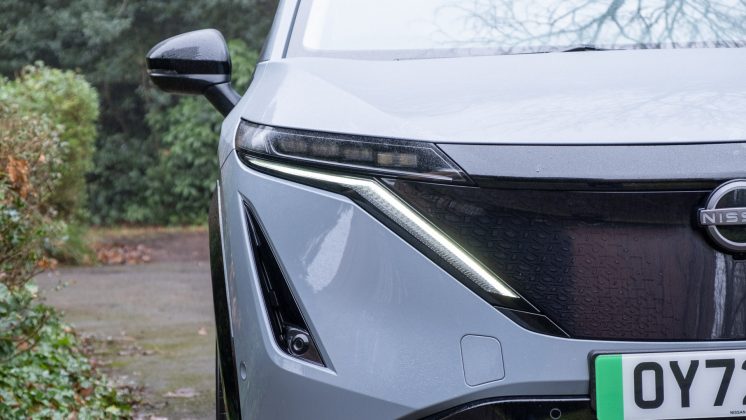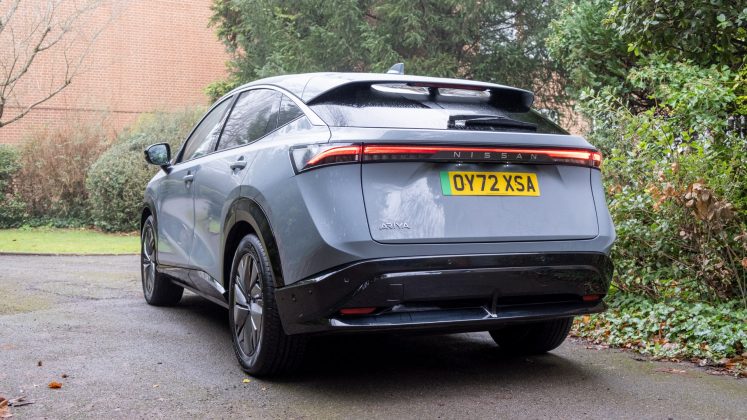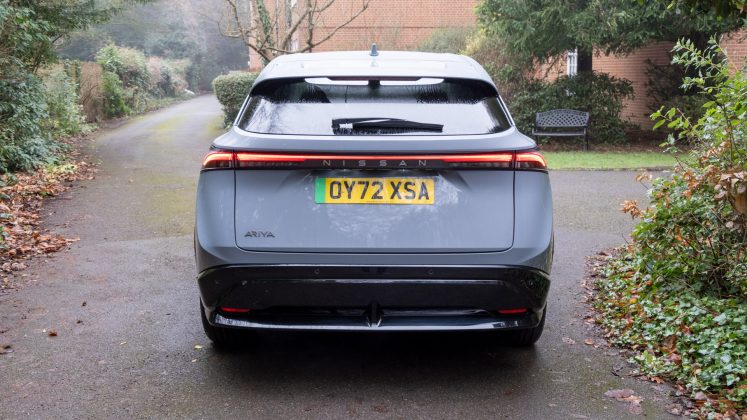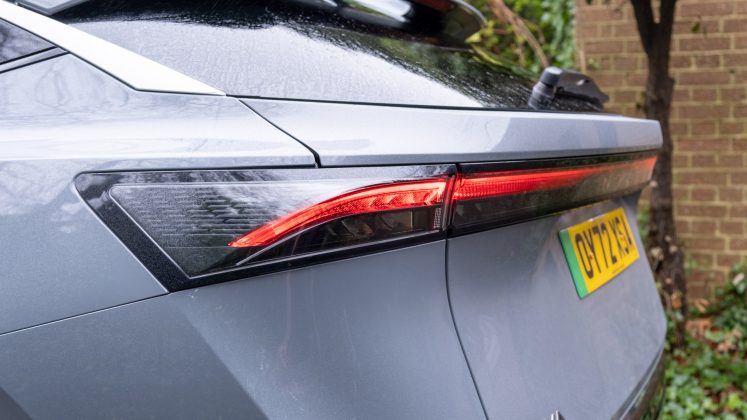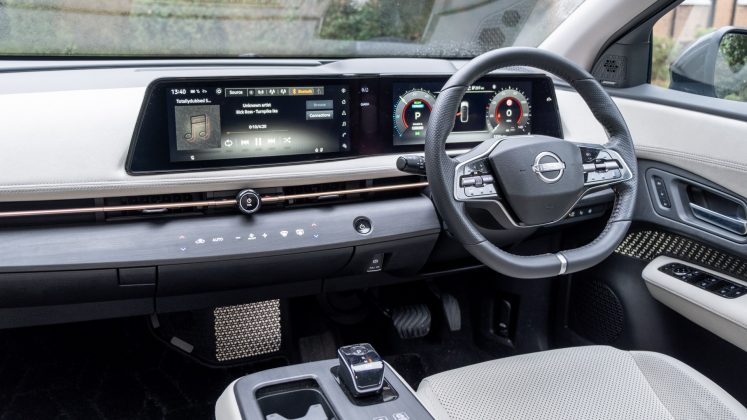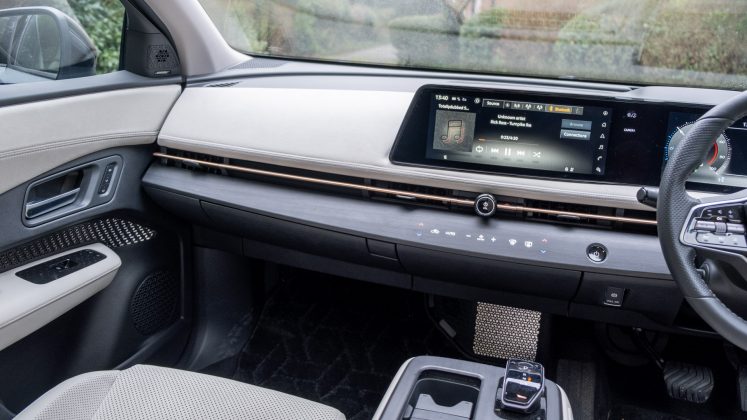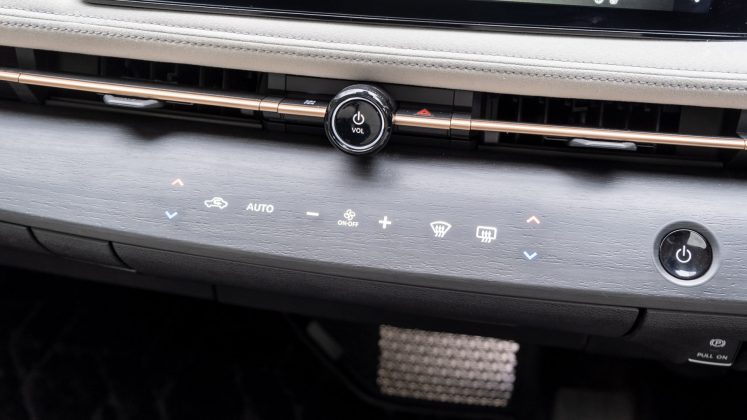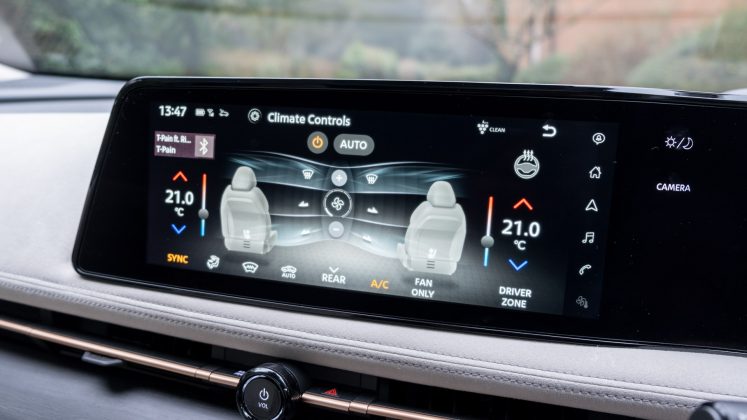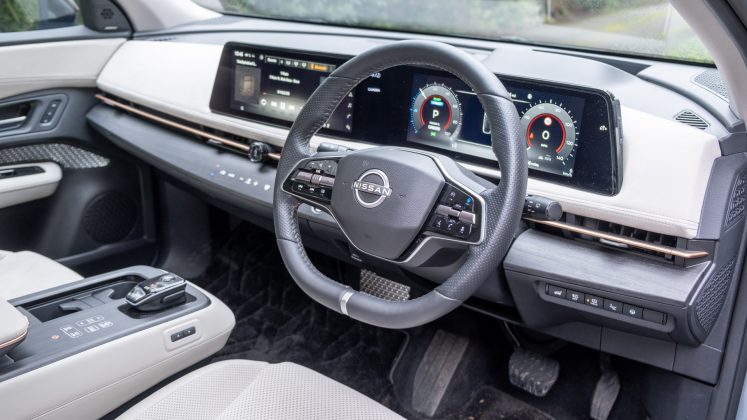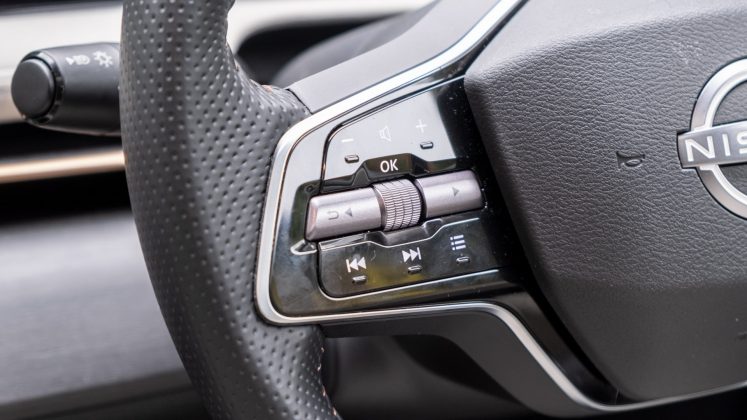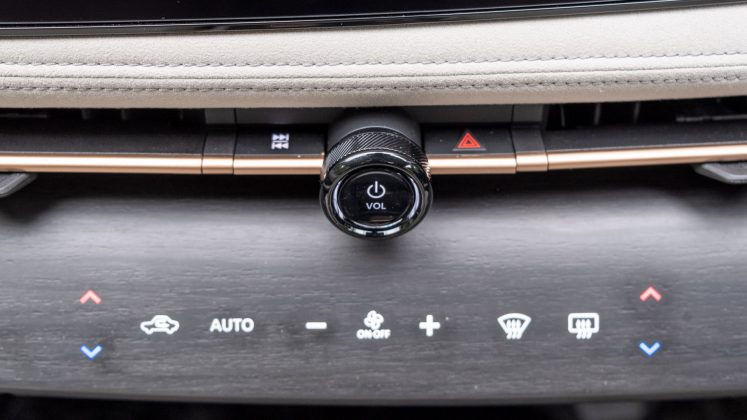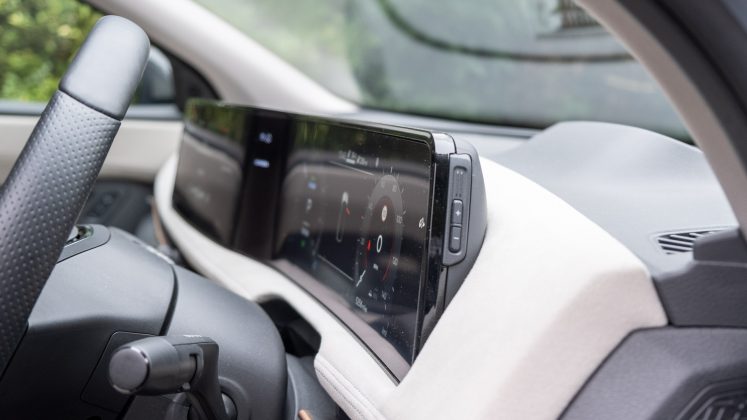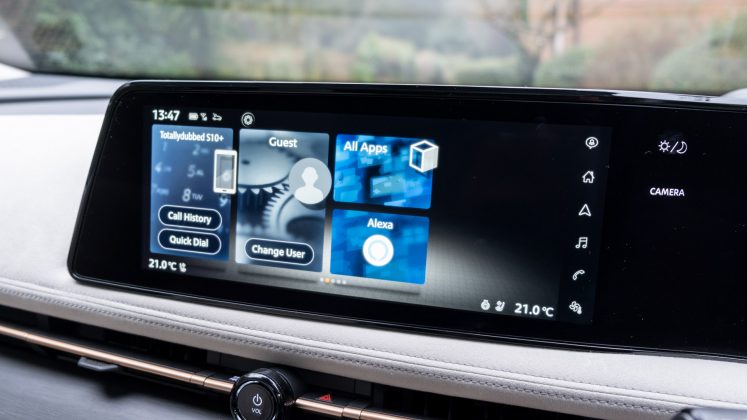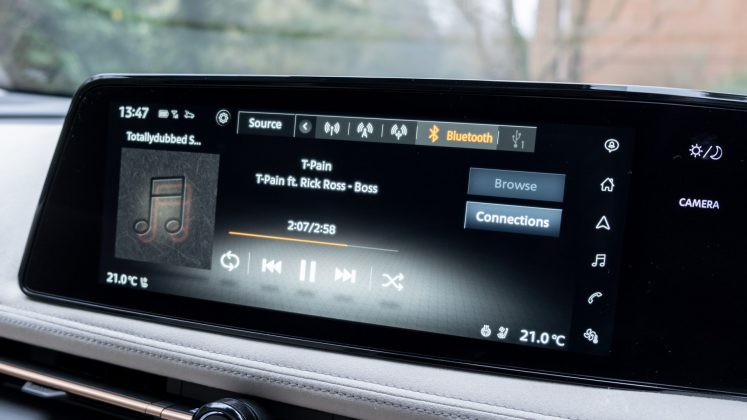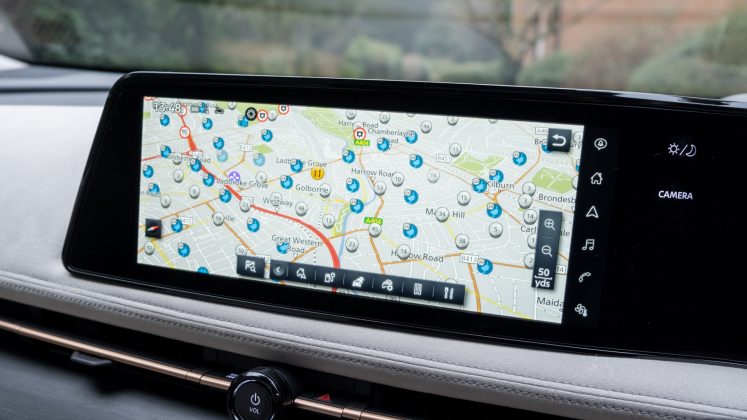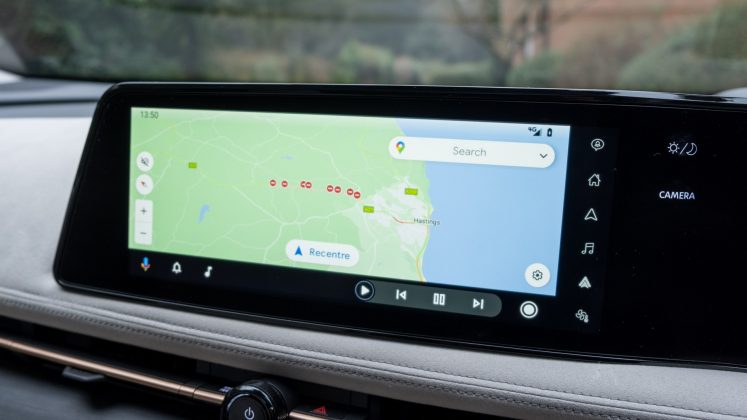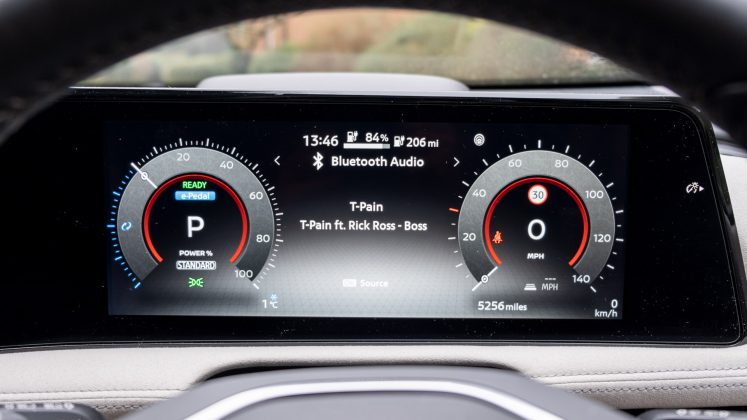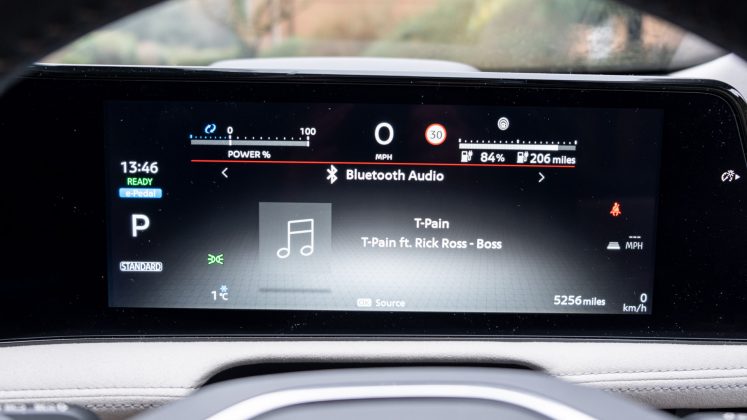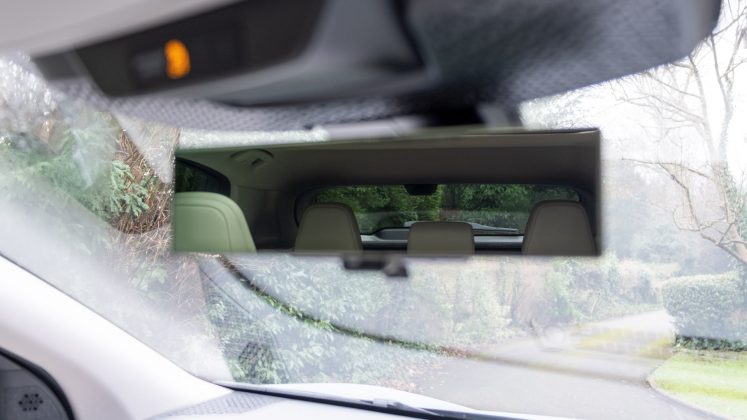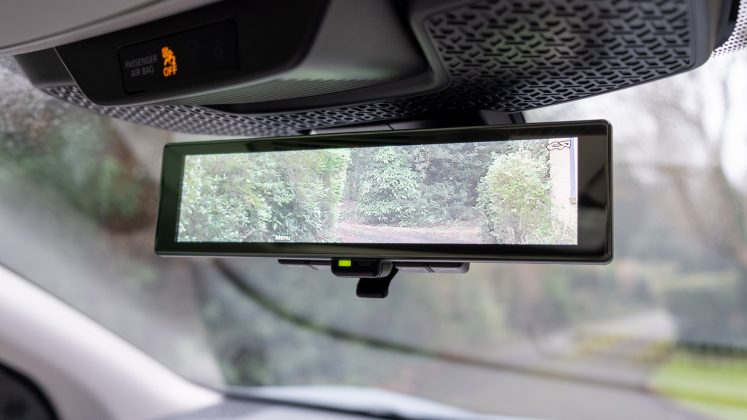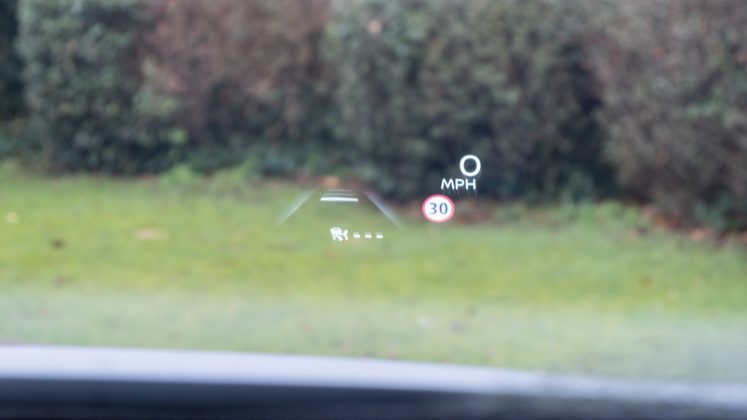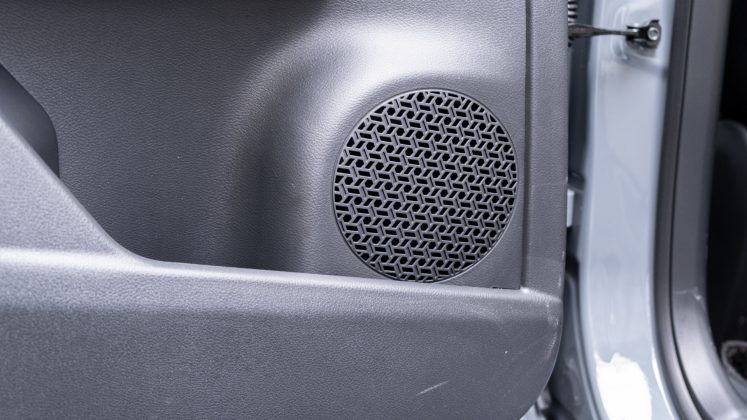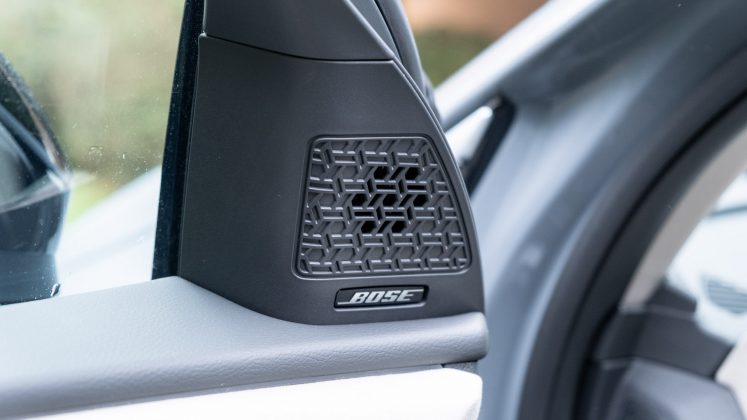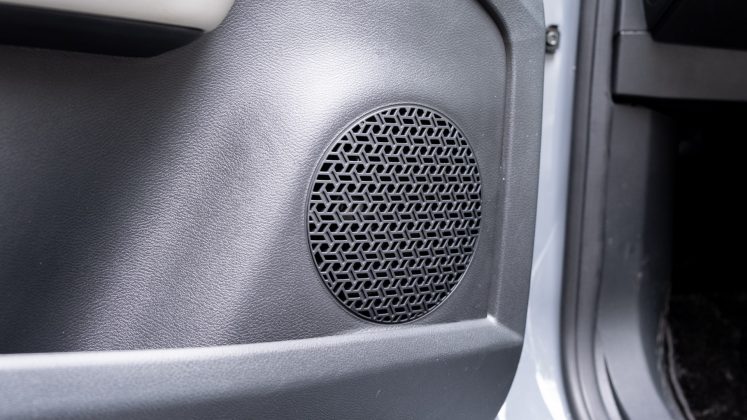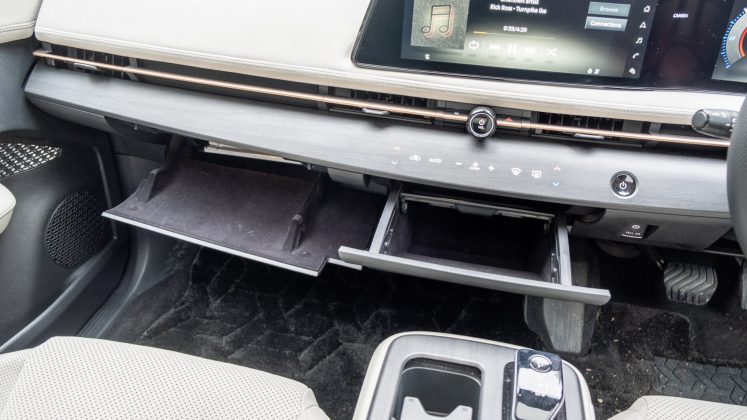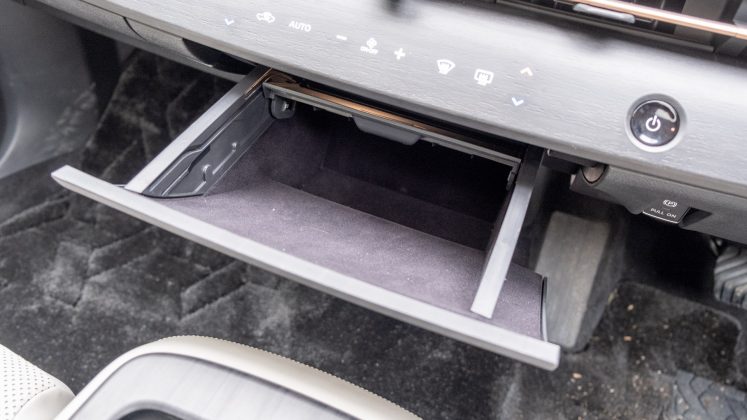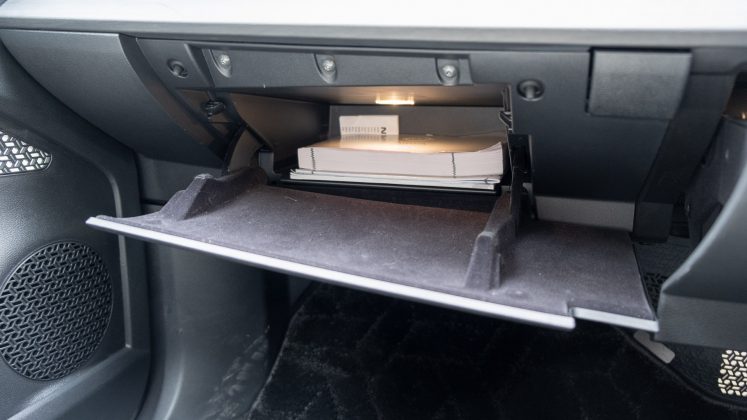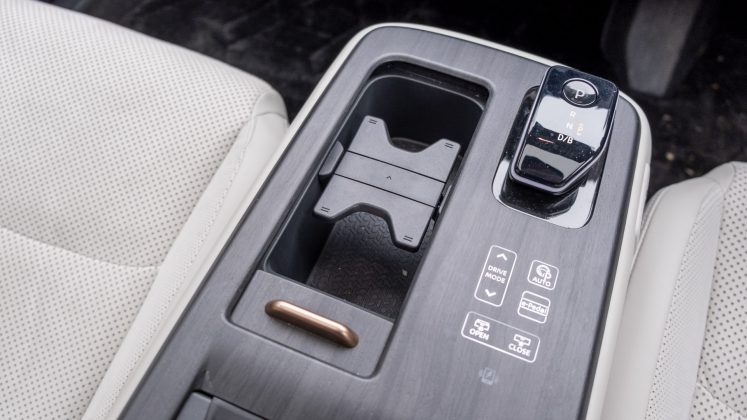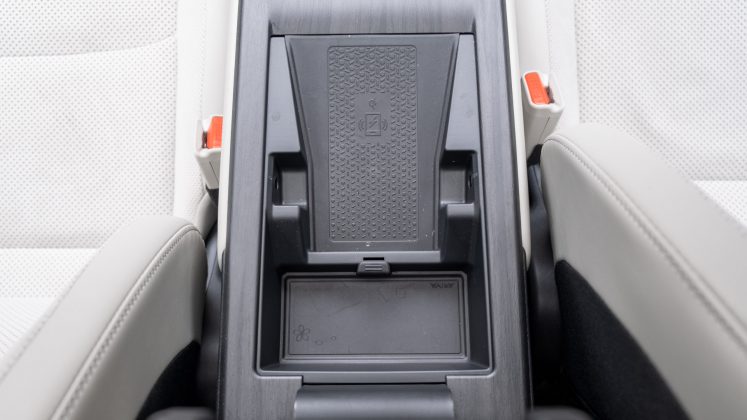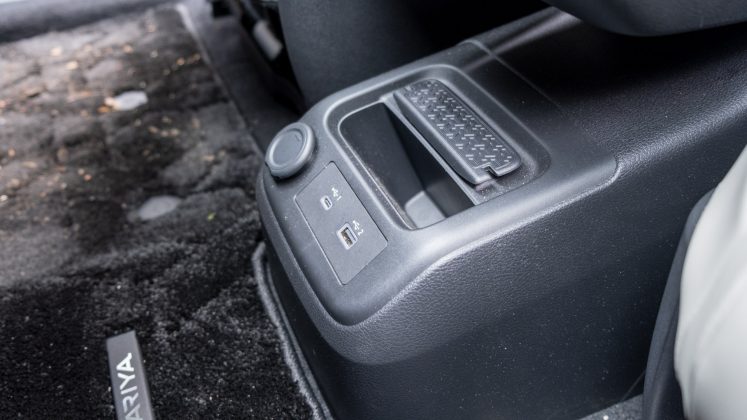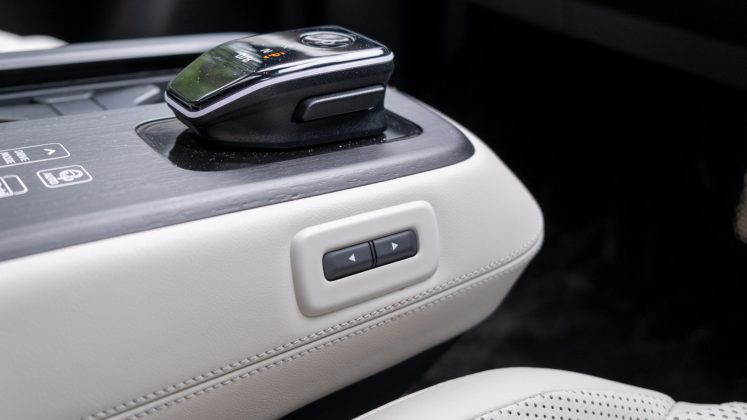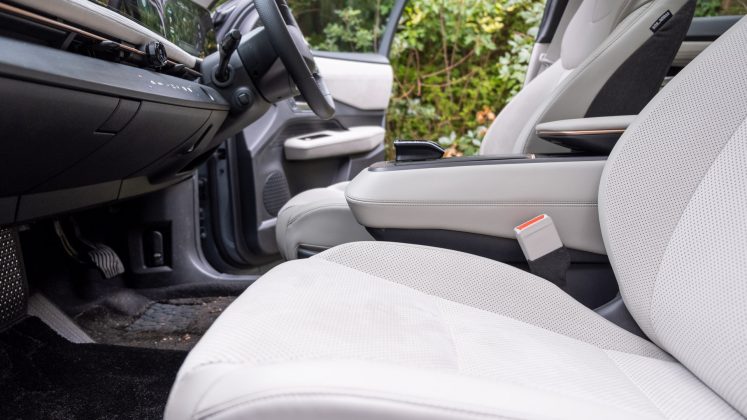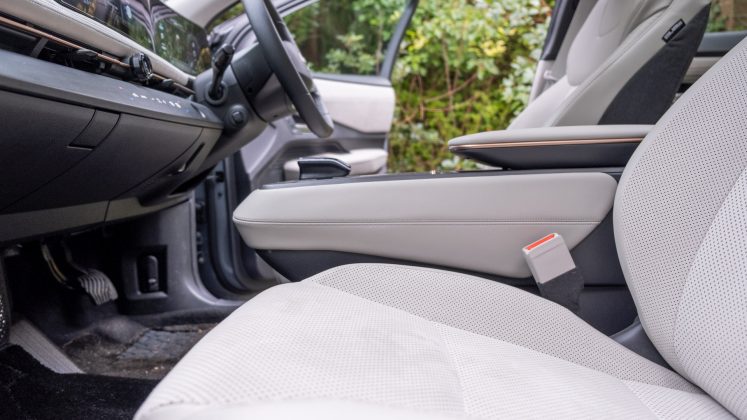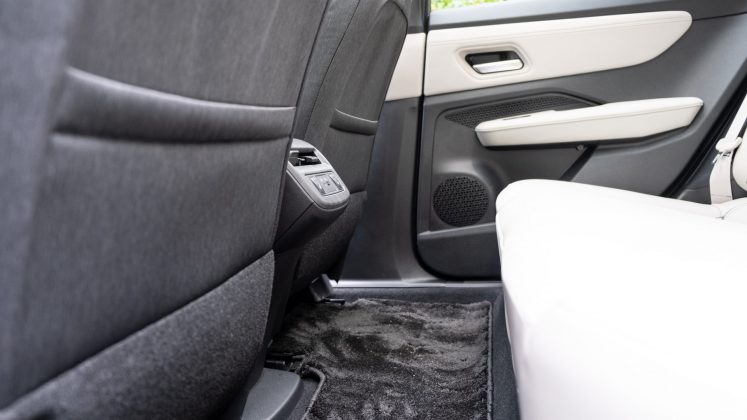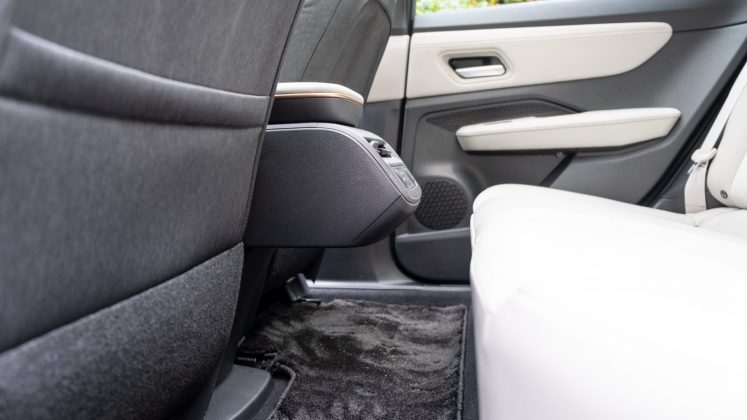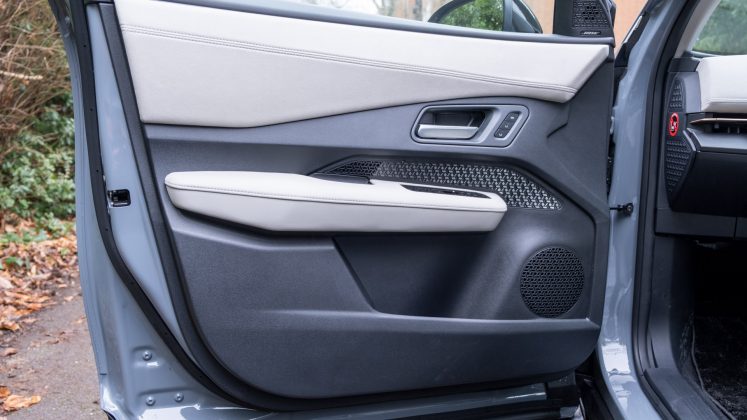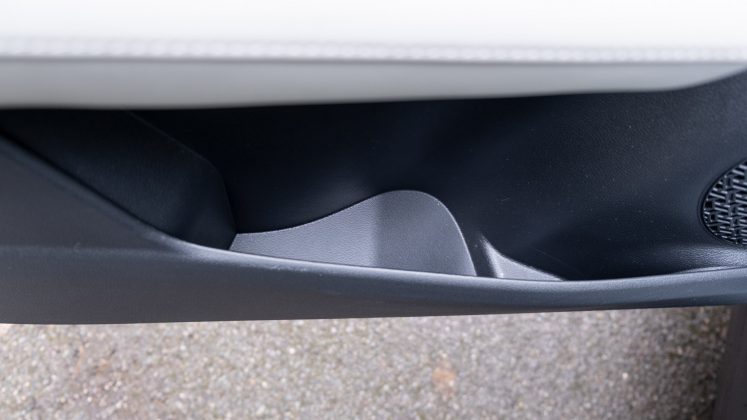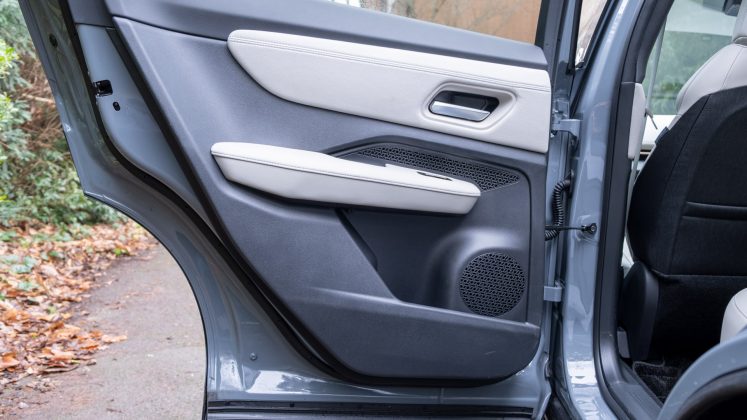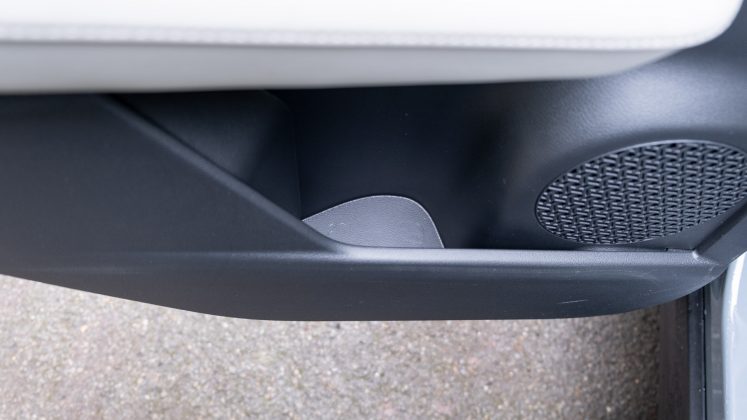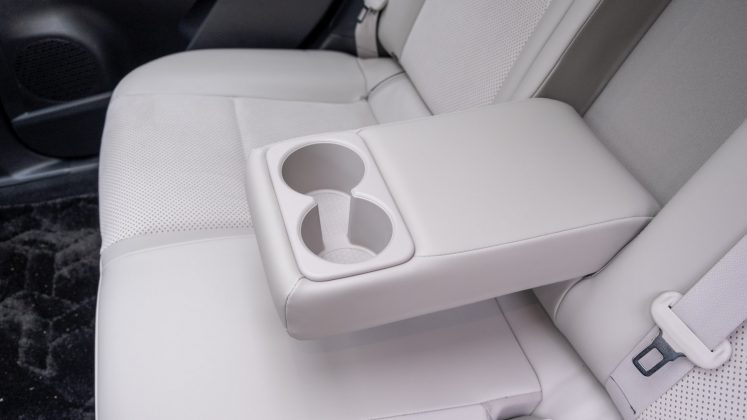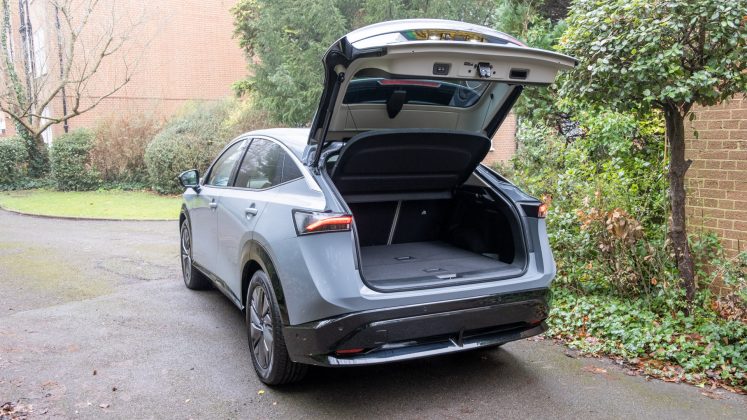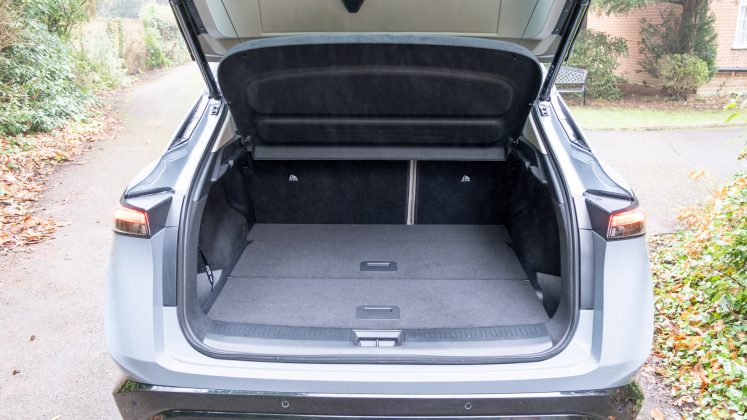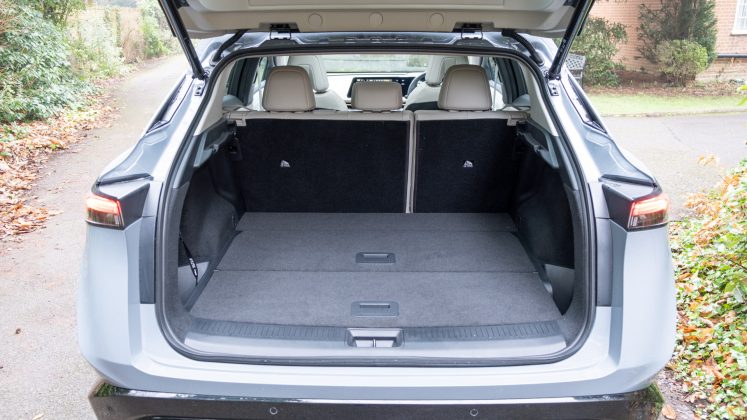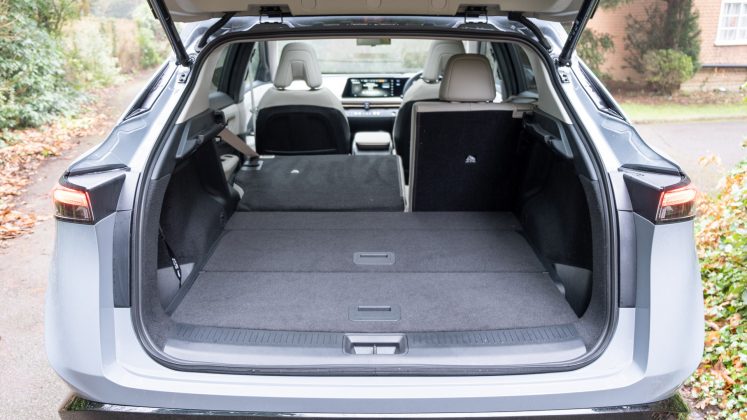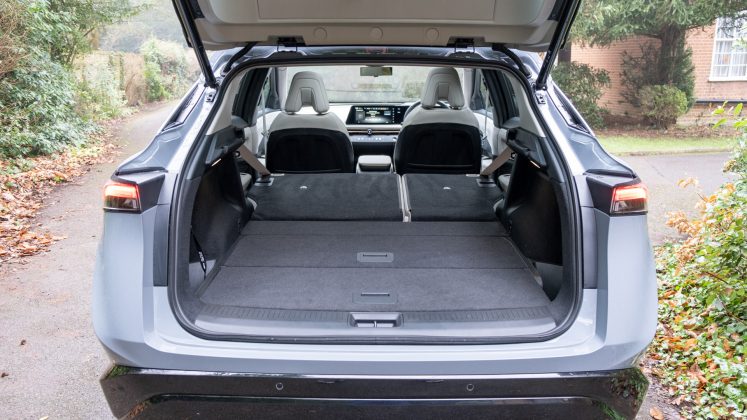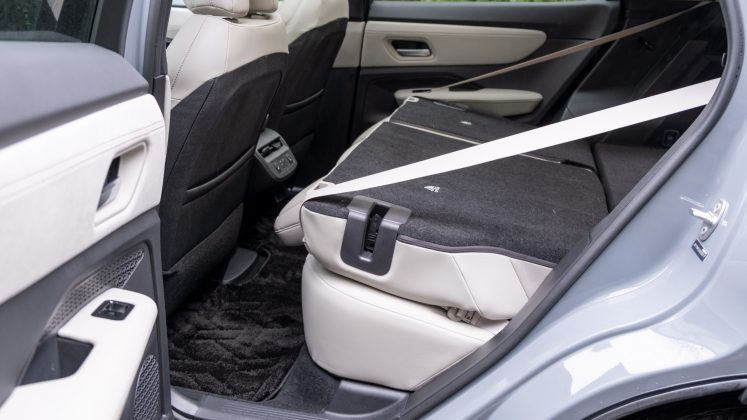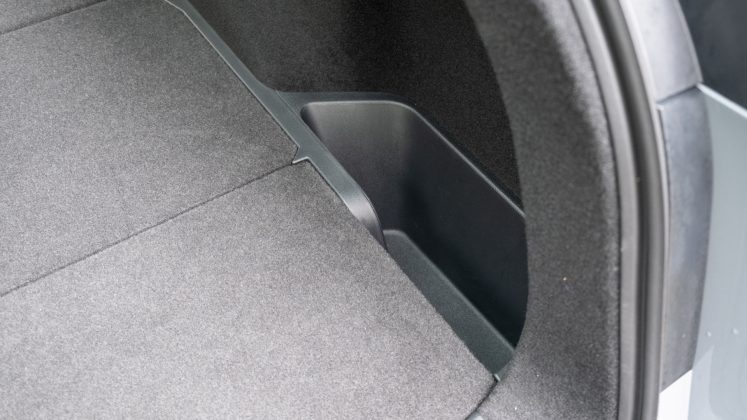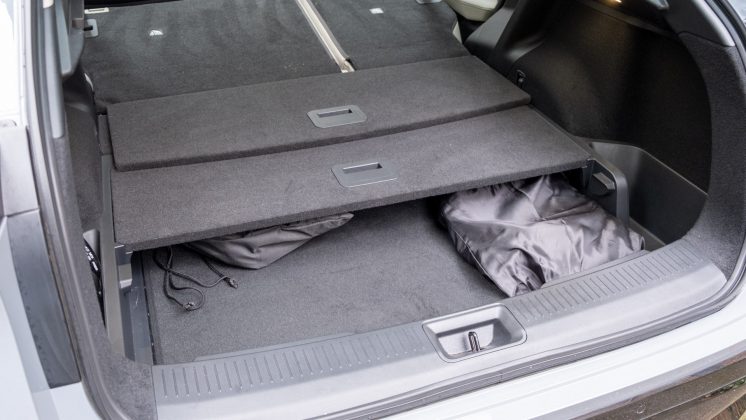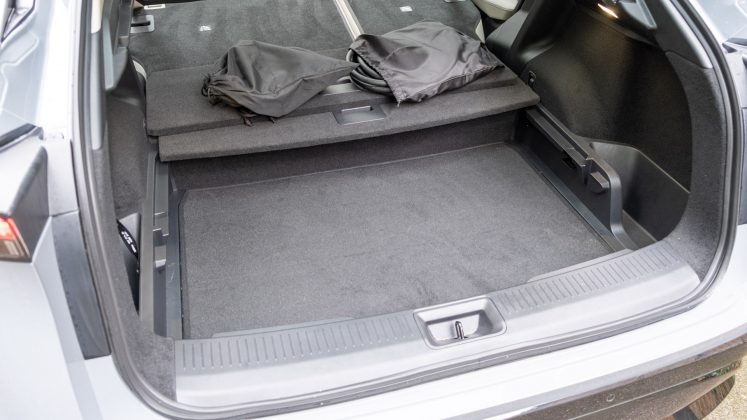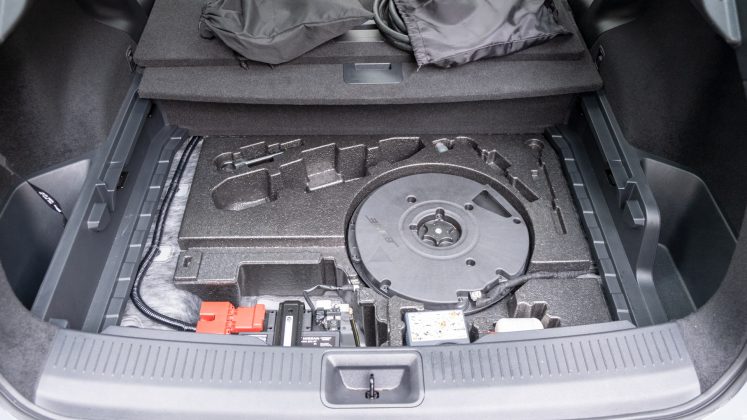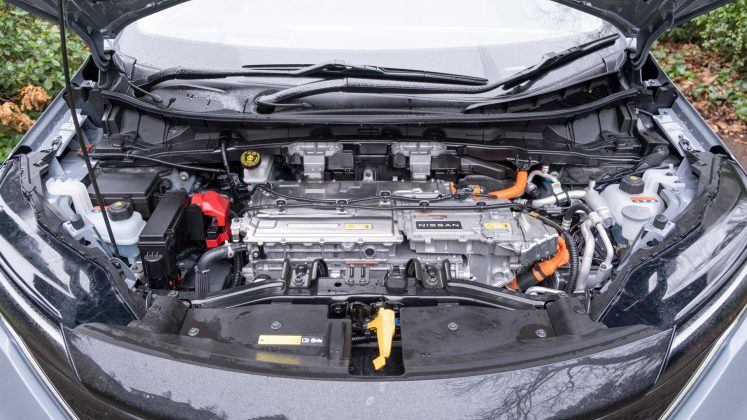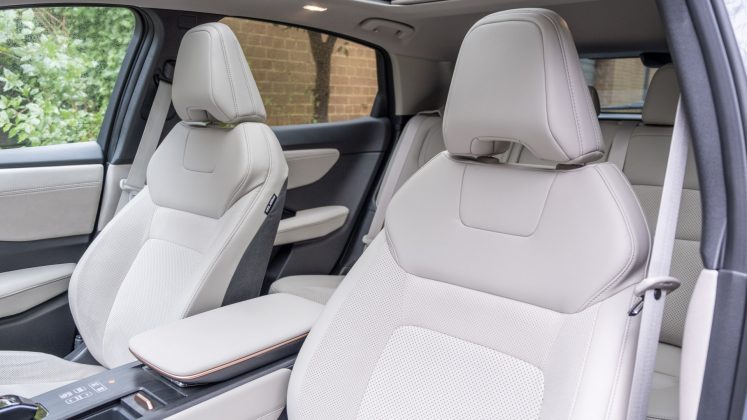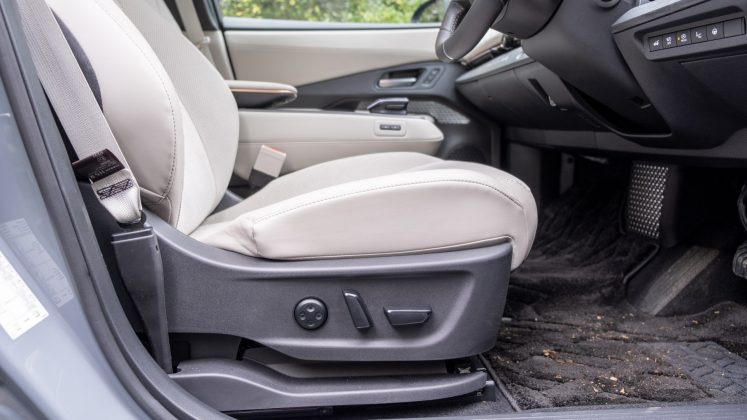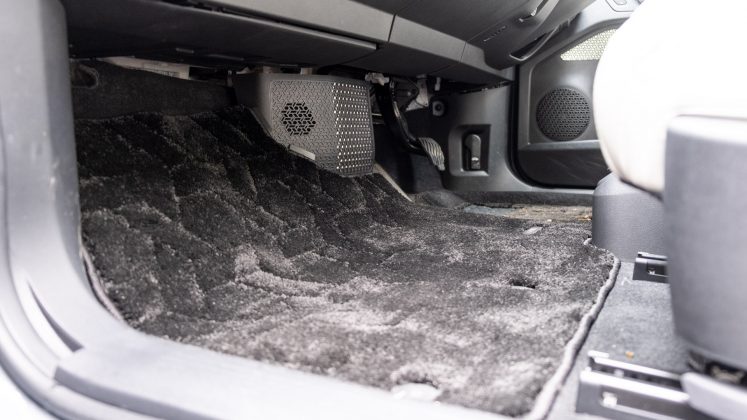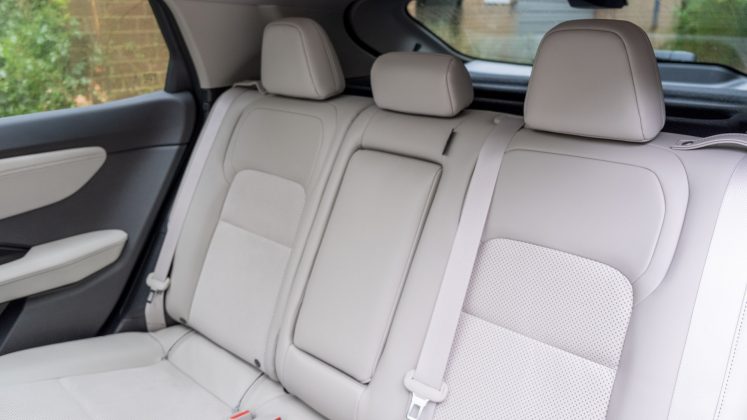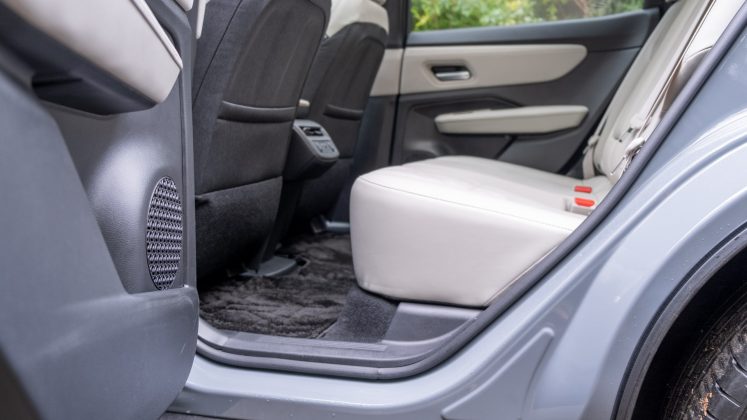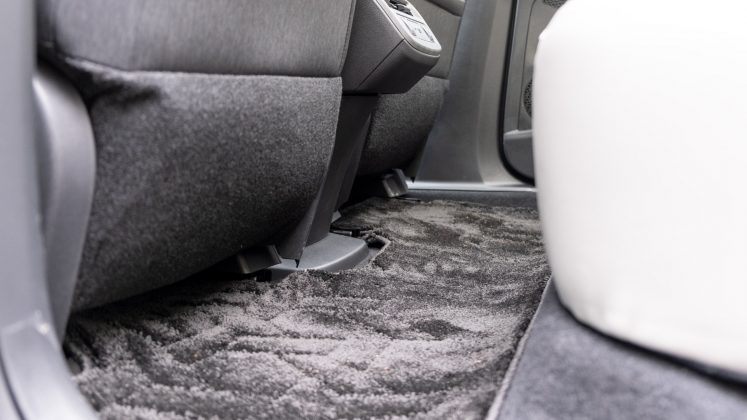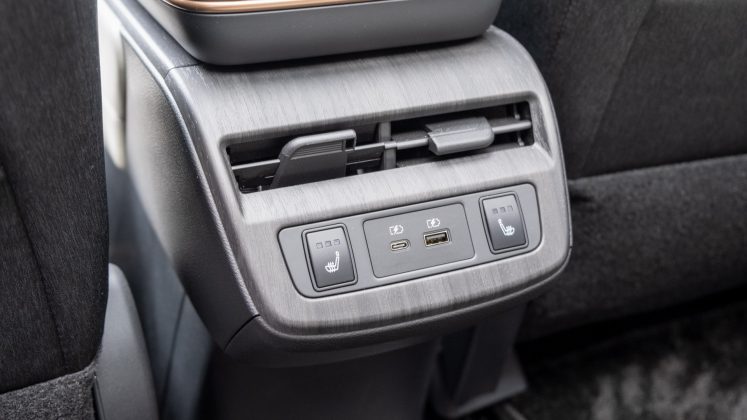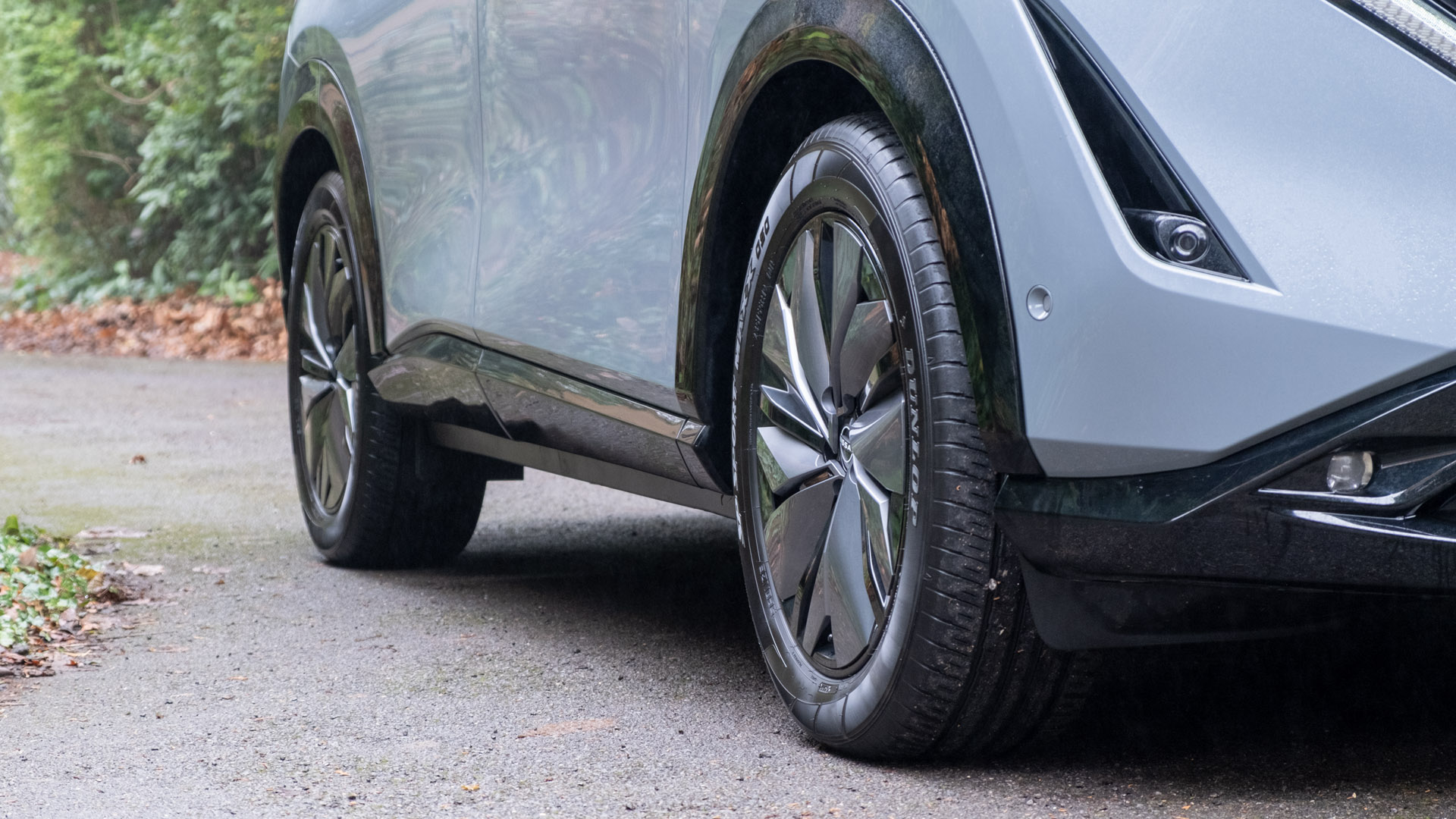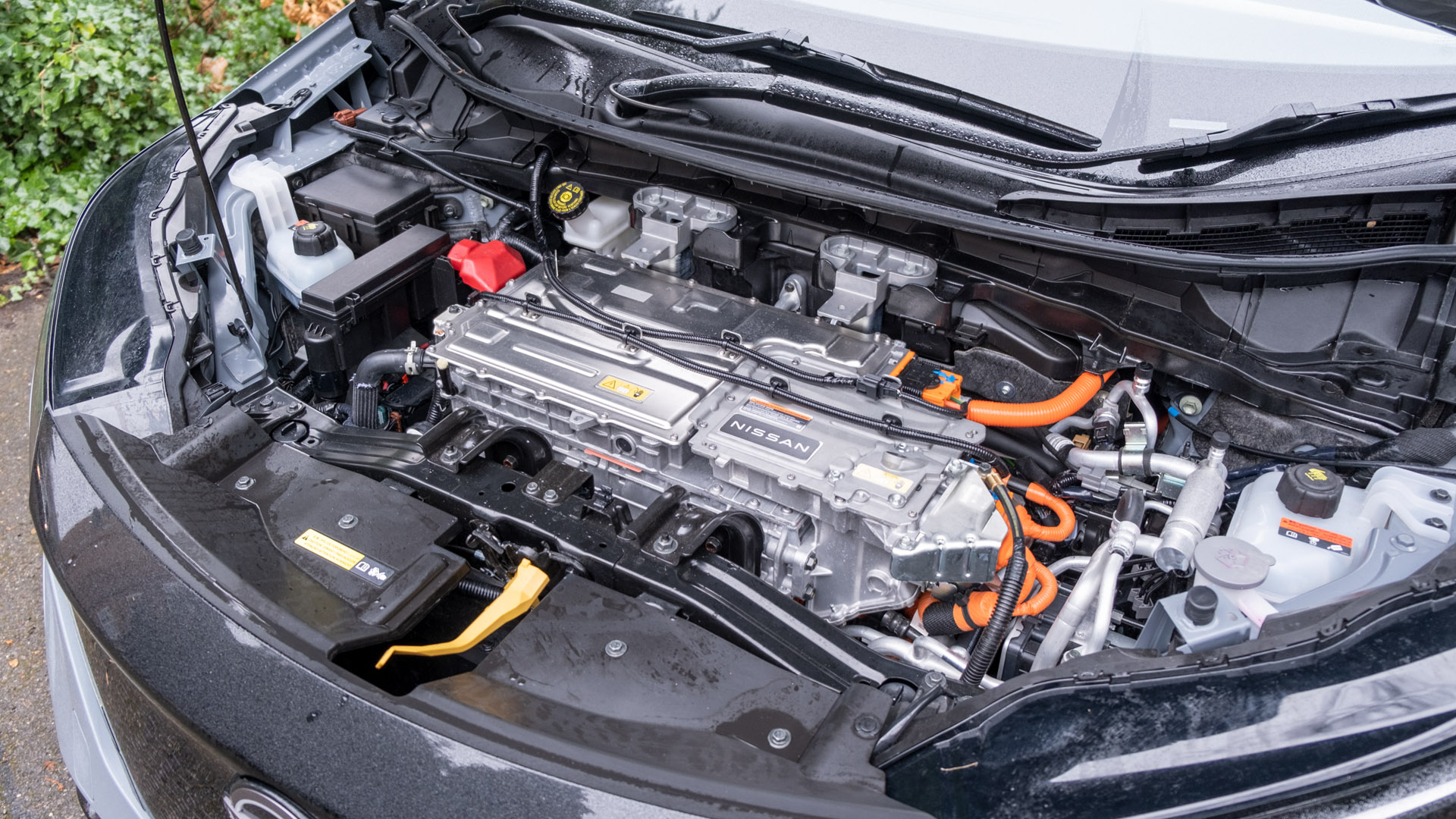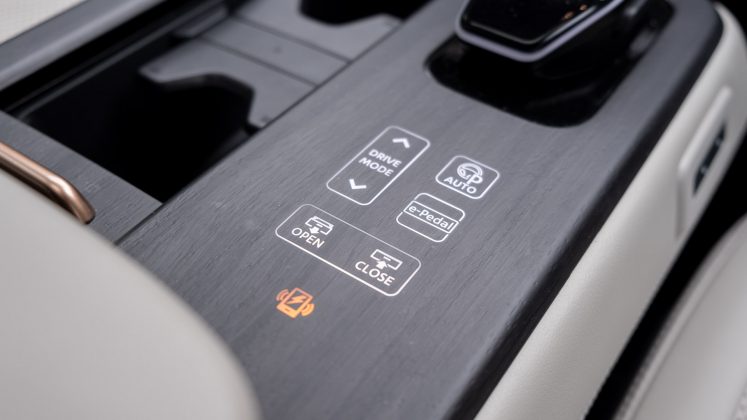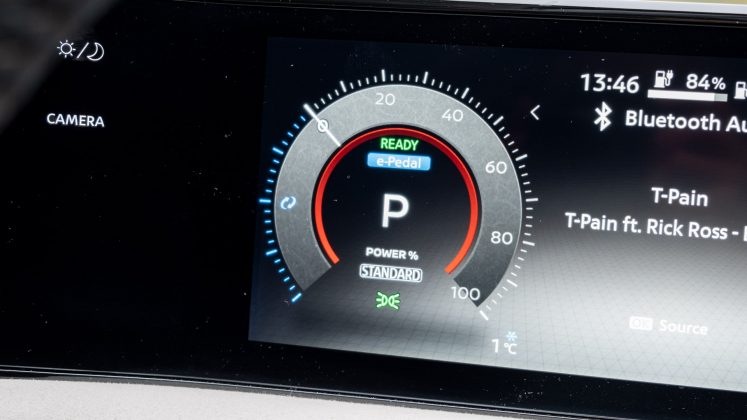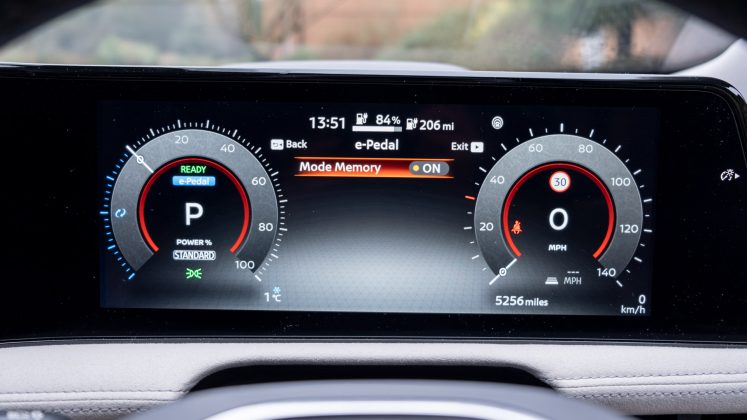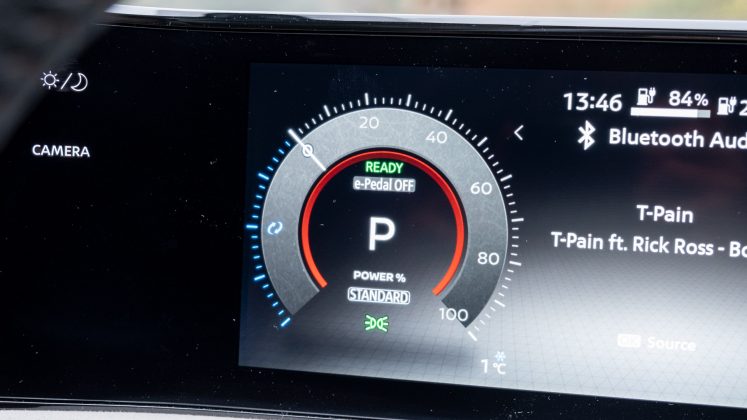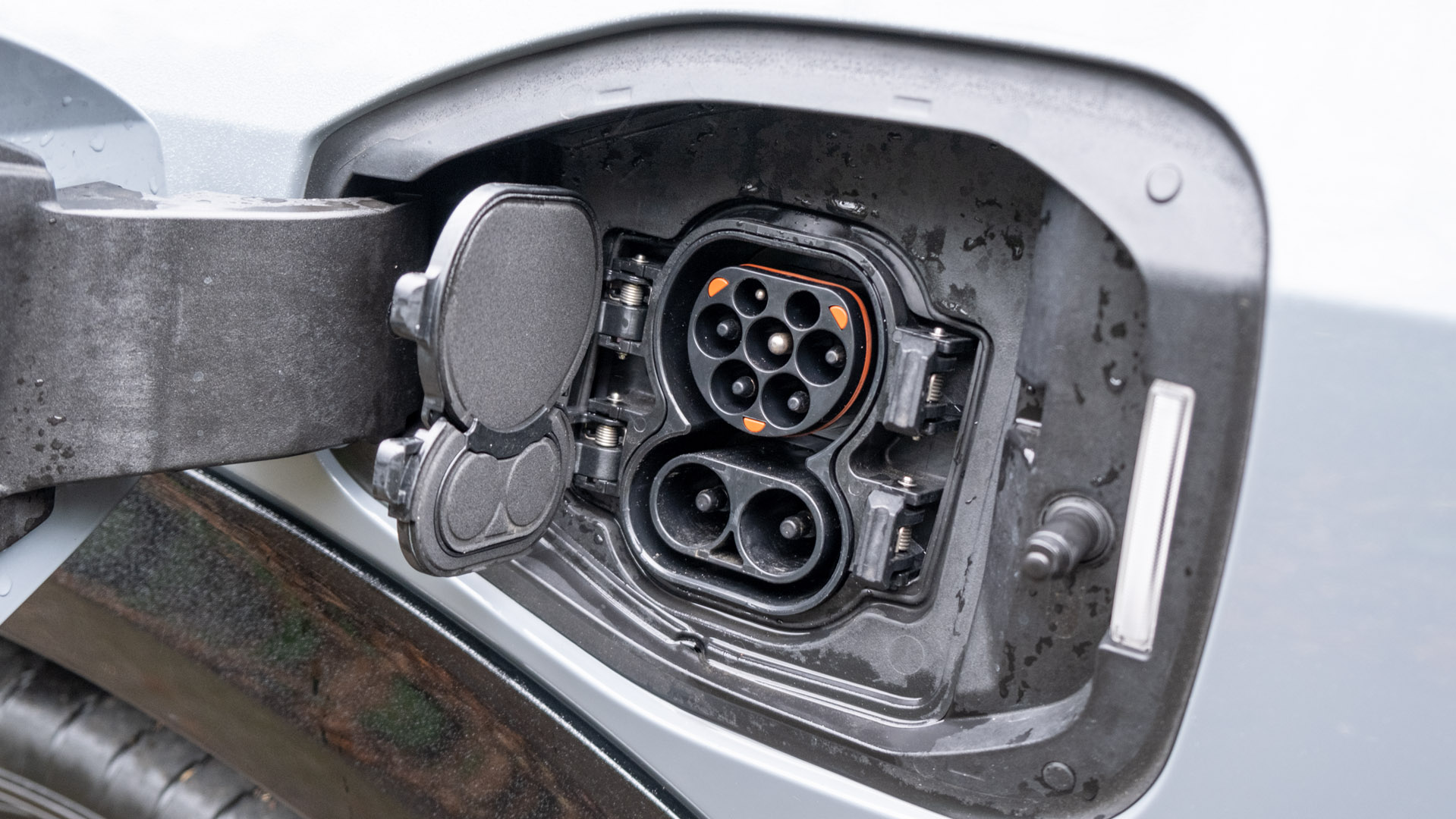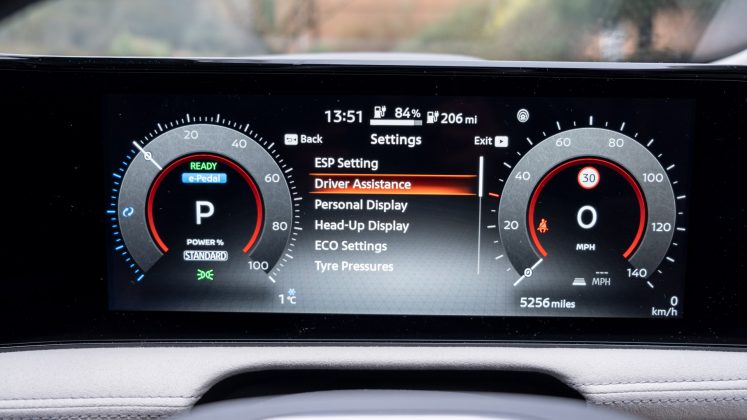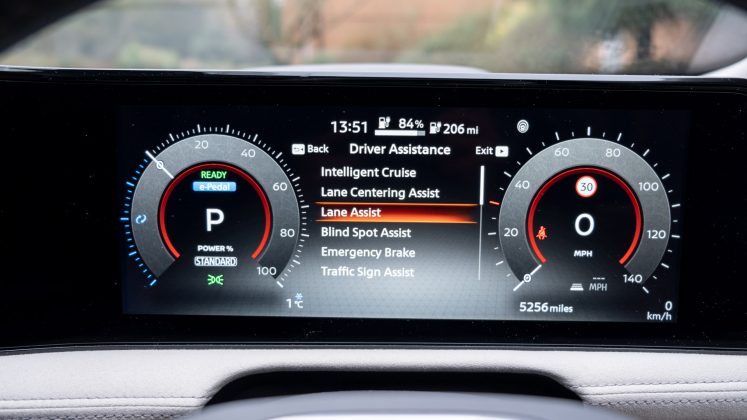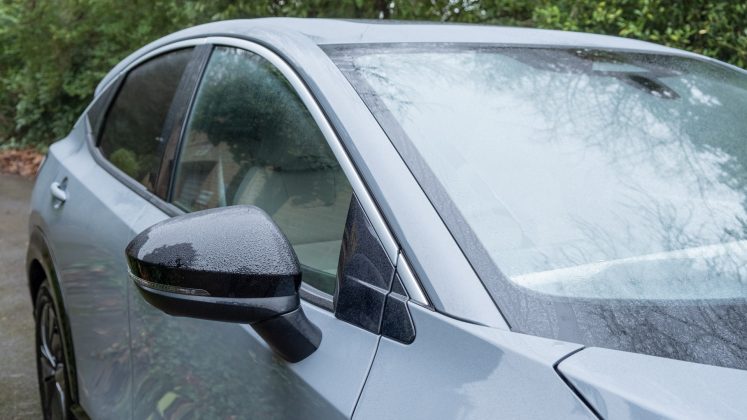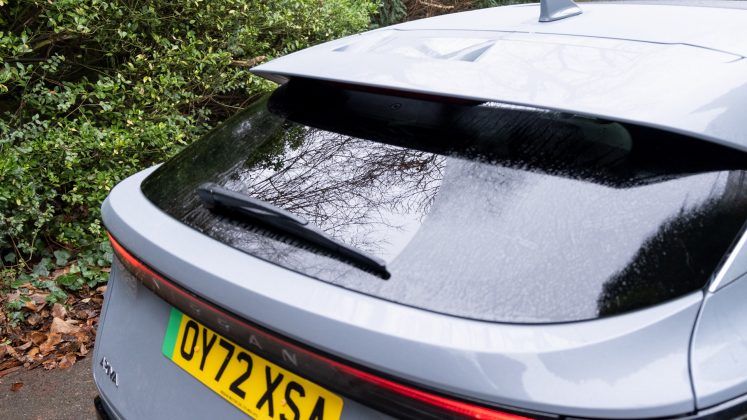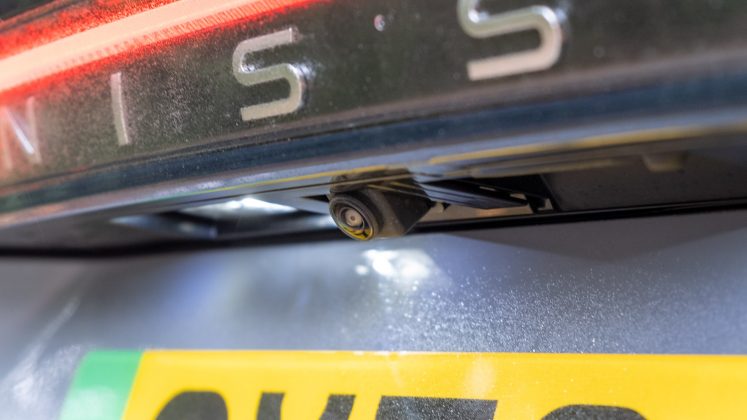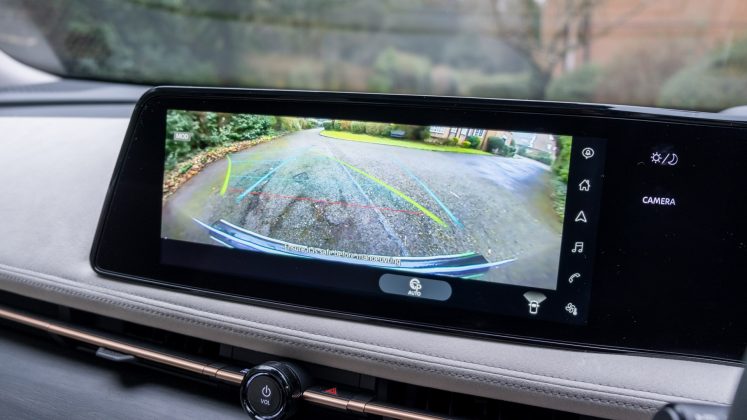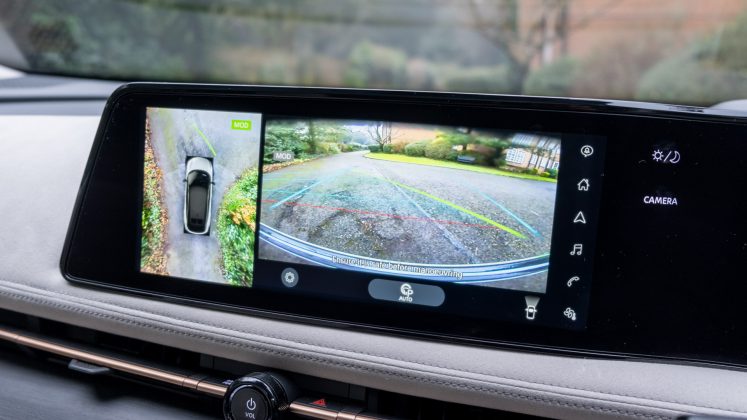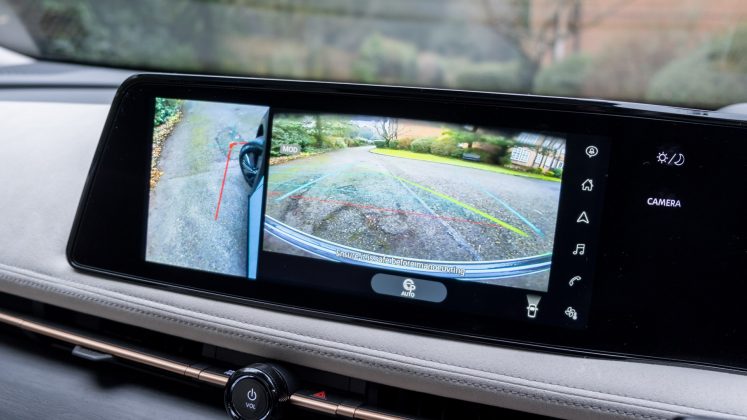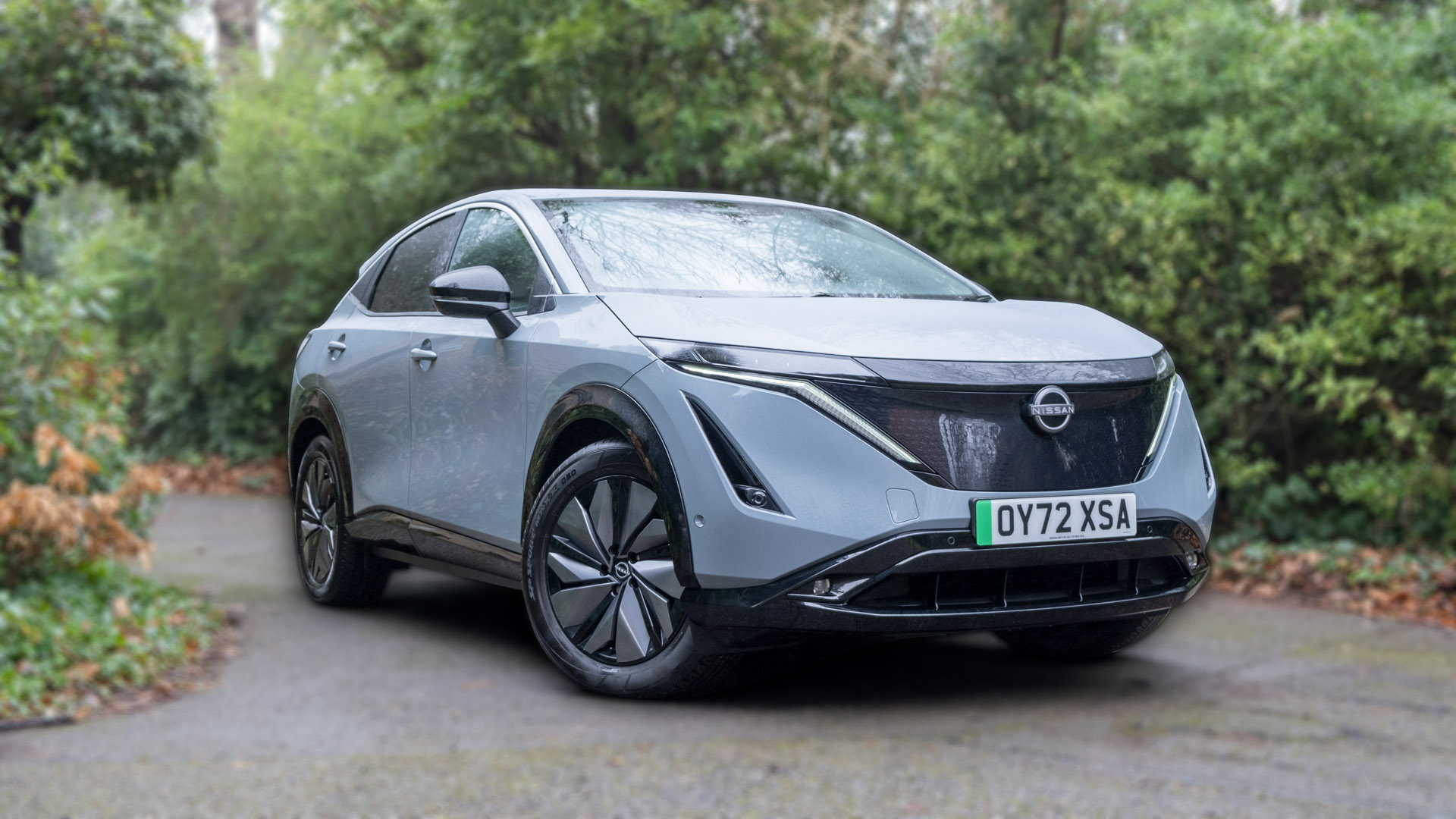The Nissan Ariya is the Japanese automaker’s second consumer-orientated fully electric vehicle. It aims to build upon the success of the Leaf, which by February 2022, sold over 577,000 units. However, unlike Nissan’s first EV which was introduced in 2010, the Ariya enters a highly competitive market with a plethora of rival manufacturers similarly offering their all-electric SUVs to aspiring customers.
If you’d prefer to watch a review of the Nissan Ariya, head on over to our YouTube channel.
Nissan Ariya price & competition
Given the automaker’s know-how in the EV space, one might expect the Ariya to undercut a lot of its rivals but alas that’s not the case. The starting price comes in at £46,145 and extends up to £58,590 without options. The Evolve 87 kWh that we have on review, with the optional Ceramic Grey metallic finish comes in at £56,635 (£55,890 + £745).
Find the best Nissan Ariya deals
As for the model line-up, there are two trims available (Advance and Evolve) with two battery pack configurations (63 kWh and 87 kWh) with a front-wheel drive (FWD) configuration. You also have the e-4ORCE all-wheel drive (AWD) models solely equipped with the larger 87 kWh battery pack. Thus, at the time of writing and in the UK, there are six variations to choose from – a breakdown of the standard equipment and your powertrain options can be found below (click to expand):
As for competition, there are plenty of all-electric SUVs to choose from: the MG4 EV from £26,995; the MG ZS EV from £30,495; the Citroen e-C4 from £31,995; the Hyundai Kona Electric from £32,450; the Kia Soul EV from £32,845; the Peugeot e-2008 from £35,900; the Vauxhall Mokka-e from £36,335; the Kia Niro EV from £36,795; the Volkswagen ID.4 from £38,845; the Skoda Enyaq iV from £38,970. You’ve also got the MG5 EV, the all-electric estate that starts from £30,995.
There is also a selection of ‘upmarket’ EVs to consider, such as: the Tesla Model Y from £44,990; the Hyundai Ioniq 5 from £43,150; the Kia EV6 from £45,245; the Volvo XC40 Recharge from £46,505; the Audi Q4 e-tron from £49,215; the Volkswagen ID.5 from £50,710; the Ford Mustang Mach-E from £50,830; the Mercedes EQA 250 from £52,010; the BMW iX3 from £64,165; the Jaguar I-Pace from £69,995; the Mercedes EQC from £74,330; and the Tesla Model X from over £102,980.
Read next: Kia Niro EV review: An upgraded e-Niro?
Nissan Ariya exterior review
Given the Ariya sits towards the premium end of the market one might expect a snazzy design and indeed, it’s got a unique look. We’d go as far as saying that it’s among the best-looking all-electric vehicles – let alone SUVs – on the market. Granted, looks are subjective, so not everyone will like its curvy profile.
We do think, however, that it takes inspiration from other vehicles. The front is a cross between a Range Rover Evoque and a Mercedes EQA, while the rear is reminiscent of the Audi e-tron. As for its side profile, there are stylish 19″ or 20″ alloy wheels with Aero covers, which are available depending on the chosen model; it is a shame, however, that the automaker hasn’t opted for body-coloured wheel arches and sideskirts. In terms of your colour options, you have nine to choose from with ‘Aurora Green’ fitted as standard.
Read next: Citroen e-C4 review: Most comfortable SUV?
Nissan Ariya interior review
The vehicle’s stylish exterior profile extends into the cabin, too. Indeed, it’s a work of art with the design of the dashboard seamlessly blending into the cockpit, and equally the quality of the stitching and upholstery are sublime; it certainly gives its fellow rivals a run for their money.
However, this does all come at a cost and by that, we’re referring to the overall practicality. Here, the use of capacitive and haptic buttons along the dashboard and centre console make for a frustrating experience while on the move – it’s a faff to adjust the climate and flick between the drive modes.
Thankfully, media controls still exist in a physical form and there’s a button to power on or off the vehicle, which has been chosen in favour of the less convenient and now-commonly used pressure sensor that some manufacturers have integrated within the driver’s seat.
Onto the use of technology, there are two 12.3″ displays that sit side-by-side. The one positioned towards the centre of the dashboard is a vivid touchscreen, which has a menu system that’s intuitively laid out. Better still, it supports Android Auto and Apple CarPlay over a wired format, with the latter also supported wirelessly; Amazon Alexa is also baked into the infotainment system, allowing for intuitive voice commands to be performed. As for the one in front of the driver, it serves as an instrument cluster providing key stats and the ability to customise the driver assistance systems.
Read next: Tesla Model Y review: Best electric SUV?
We do have a few complaints, however, as the aggressive coating for the infotainment display dampens the viewing experience and makes for a rather cheap look. The driver’s view also fails to integrate turn-based navigation data from the supported third-party mobile operating systems; which is a shame as a few of its rivals offer said functionality.
Thankfully, the system’s built-in navigation is fed through to the instrument cluster and the Head-Up Display (HUD), whereby the projected screen is present on the Evolve trim or available as part of the Bose Tech Pack in the Advance model for £1,750. This also adds the ‘Intelligent Rear View Mirror’, which at the flick of a lever allows you to access the vehicle’s rearview camera straight from the mirror – clever thinking by Nissan and Bose.
Unsurprisingly, this pack also upgrades the stock 6-speaker audio system to a 10-speaker Bose configuration, which adds some extra oomph and dynamism to music. You can hear how the latter system performs by watching our dedicated audio review on YouTube.
Nissan Ariya storage review
The use of technology doesn’t stop there, as the centre console in the Evolve trim is moveable. This allows you to customise the amount of space within the cabin, which might seem like an over-engineered feature, but a nice touch.
Speaking of which, in the more expensive model, you’ll also find a powered storage compartment that can be prised open by touching and holding the relevant button found engraved on the centre console. Indeed, there’s additional storage that can be electronically locked away – the Advance trim opts for a more traditional approach with a physical release button; replicating the glove box which can be found just beside it.
As for smaller areas to store your valuables, you’ll find two cupholders within the centre console and further down, a wireless phone charger alongside a small area for the remote. At the rear, there’s also a small are towards the rear portion of the centre console, and a pull-down armrest that also reveals two cupholders.
In terms of the door bins, they’re large and accommodating, especially at the front of the cabin, however, it’s a shame that none of them are lined with any fabric. This means your loose change or keys will be heard rattling around while driving.
So, what about its boot capacity? Well, Nissan claims there’s 466 litres in the FWD models and 408 litres in the AWD variants (due to the placement of the second motor). However, the manufacturer hasn’t shared a figure with the seats propped down. We can only hazard a guess of around 1,500 litres.
Here is how it stacks up to its rivals: Tesla Model Y (854/2,100 litres); Audi e-tron (660/1,725 litres); Skoda Enyaq iV (585/1,710 litres); VW ID.5 (549/1,561 litres); VW ID.4 (543/1,575 litres); Hyundai Ioniq 5 (520/1,587 litres); BMW iX3 (520/1,560 litres); Jaguar I-Pace (656/1,453 litres); Audi Q4 e-tron (520/1,490 litres); MG5 EV estate (464/1,456 litres); Kia Niro EV (475/1,392 litres); Peugeot e-2008 (434/1,467 litres); MG ZS EV (448/1,375 litres); Kia EV6 (490/1,300 litres); Volvo XC40 Recharge Twin (452/1,328 litres); Ford Mustang Mach-E (402/1,420 litres); Kia Soul EV (315/1,339 litres); Citroen e-C4 (380/1,250 litres); Mercedes EQA (340/1,320 litres); MG4 EV (363/1,177 litres); Hyundai Kona Electric (332/1,114 litres); Vauxhall Mokka-e (310/1,060 litres).
When it comes to convenience, all models have an electric and hands-free tailgate fitted as standard with a hatchback design, making it easy to access the rear of the vehicle. Equally, there’s a flat loading bay with sizeable underfloor and side compartments for your charging cables or shopping.
However, the rear seats opt for a 60:40 split-folding design with no through-loading capacity due to the omission of a ski latch. There’s also no front storage compartment (frunk) either, which will come as a disappointment to certain EV enthusiasts.
Read next: Skoda Enyaq iV review: The Volkswagen ID.4 alternative
Nissan Ariya comfort review
Now with a staple Japanese interior design, one might expect class-leading comfort and in part, the automaker lives up to expectations. Both headroom and legroom are sufficient, whereby 6-foot (182cm) individuals are comfortably accommodated throughout the cabin; the optimisation of both the front and rear footwells is also a contributing factor.
Both front seats have a ‘Zero Gravity’ design, which aside from the marketing term, do play a role in providing a good degree of support to your lower back. They’re both accommodating, electronically operated, heated and the driver’s seat has lumbar support too. On that note, the steering wheel is heated as standard too.
In the Evolve trim, you’ll also get ventilated front seats and heated rear outer seats. The more premium model also has the option to be fitted with an electric sunroof and a retractable sunshade – it’ll set you back £1,295.
Find the best Nissan Ariya deals
As for cabin noise, it’s kept down to a minimum with exterior noise suppressed even at higher speeds. It outclasses some of its competitors in this department and provides a serene environment – you’ll find our sound measurements in our dedicated audio review.
However, the in-cabin experience takes a nosedive when the vehicle is in motion. Due to the vehicle’s soft suspension setup, the front-wheel drive (FWD) models bounce around when traversing uneven terrain. The effect is severely amplified at higher speeds. We’d go as far as saying that if you suffer from motion sickness you might want to do a motorway test drive prior to committing to the Ariya, as it might throw you off the purchase altogether.
With that said, the all-wheel drive (AWD) models are far more planted to the ground and with e-4ORCE technology working its magic with both the front and rear axles, the bouncing phenomenon is drastically reduced, if anything eliminated altogether. To some degree, we wish all Ariya models were fitted with e-4ORCE, but of course, this would require all variants to operate on an AWD configuration.
Read next: Kia EV6 review: The Hyundai Ioniq 5 alternative
Nissan Ariya performance review
Similarly, the FWD’s handling characteristics are hampered by the SUV’s large frame suffering from body lean when cornering at speed. The steering wheel also feels disconnected and lacks that driver’s feel of some of its rivals. With that said, we suspect the target market for the FWD models won’t factor these into their purchasing decision.
Rather, the Ariya’s inability to keep the front wheels from spinning when laying down the power will be of concern for those with a heavy foot. While it isn’t as severe as the Hyundai Kona Electric, which also suffers from torque steer, the Ariya doesn’t bring confidence when driving on wetter tarmac or more challenging roads. Yet again, the e-4ORCE variants solve the issue by splitting the power delivery across both axles.
On the notion of putting your foot down to the metal, the FWD 87 kWh Evolve on review generates 178kW (238hp) of power and 300Nm of torque from its front-mounted motor and battery pack. We had it tested from 0-60mph using Racelogic’s Vbox Sport, at 8.36 seconds. Top speed is capped at 100mph. It’s not exactly exhilarating and in comparison to some of its rivals, fails to provide that fun EV experience.
Read next: Volkswagen ID.5 review: Germany’s best electric SUV?
While this might not be of great importance to certain individuals, the vehicle’s electric range plays a role in consumers’ purchasing decisions. From our own mixed driving tests, we netted a very respectful figure 240-260 miles. It’s worth noting that unlike some of its competitors, all Ariyas – including the base model – are fitted with a heat pump; a much-loved inclusion for those who live in countries with colder climates as it maximises battery efficiency by safely feeding heat dissipated from the battery pack into the cabin.
Now to put its range into context, here’s how its rivals faired in our tests: Peugeot e-2008 140-160 miles; Vauxhall Mokka-e 150-170 miles; Citroen e-C4 180-200 miles; Mercedes EQA 250 210-220 miles; Kia Niro EV (no heat pump) 205-225 miles; MG4 EV Long Range 220-240 miles; Ford Mustang Mach-E RWD Standard Range and BMW iX3 230-240 miles; MG ZS EV Long Range, Jaguar I-Pace and Hyundai Ioniq 5 AWD 230-250 miles; Kia EV6 RWD 240-260 miles; Hyundai Kona Electric 64 kWh, Kia Soul EV (with heat pump), Audi Q4 40 e-tron and VW ID.4 (no heat pump) 260 miles; Tesla Model Y Long Range 250-280 miles; Skoda Enyaq iV 80 300 miles and the VW ID.5 RWD Pro 77 kWh coming in at a whopping 325 miles.
Much like every other fully electric vehicle on the market, the Ariya has the ability to recoup energy back into its battery pack via the use of regenerative braking. B-mode can be initiated by shifting down on the gear selector. There is also e-Pedal mode, which can be toggled via the dedicated touch-based button found on the centre console. Here, it’s great to see that the Ariya can retain its e-Pedal mode state upon every cold start, thus not being required to be toggled on or off each time you step inside the cabin.
However, unlike its older sibling, the Nissan Leaf and a few of its rivals, e-Pedal mode doesn’t permit you to drive with one pedal. Indeed, the Ariya will roll at roughly 6-7mph even in its harshest regenerative braking setting; a truly baffling decision by the Japanese automaker and further, disappointing that there isn’t a means of adjusting the level of deceleration either.
Buy a car phone mount on Amazon (Affiliate)
To recharge at a much more rapid rate, there’s a CCS and Type 2 port. The Ariya can take up to 130 kW via the former input. Meaning a 20-80% charge will take roughly 30 minutes. Connected to an AC charger, the 87 kWh models have a 22 kW onboard charger (OBC), while the 63 kWh models are limited to 7.4 kW. One can upgrade the OBC for £895 on the smaller battery pack variants.
As such, at 22 kW it’ll take 5 hours to full in the 87 kWh model and 3.5 hours in the 63 kWh variant. Should you not have access to three-phase charging, it’ll sit at 13.5 hours and 10 hours respectively when connected to a 7.4 kW wallbox. A 3-pin socket drastically increases the time up to 48 hours and 34.5 hours.
Read next: Jaguar I-Pace review: Better than newer rivals?
Nissan Ariya safety review
In terms of safety, the Ariya scored 5/5 stars on Euro NCAP’s rigorous crash tests. Managing 86% in Adult Occupancy, 89% in Child Occupancy, and a very impressive 91% in the Safety Assist tests.
On the subject of advanced driver assistance systems (ADAS), there are a plethora of them included as standard across all trim levels, which is a rare and welcome sight among its competitors. Here you’ll find all of the following: ProPILOT Assist with Navi-Link, Intelligent Driver Alertness, Intelligent Lane Keep Assist, Traffic Jam Pilot, Intelligent Blind Spot Intervention, Rear Cross Traffic Alert, Intelligent Speed Assist, Intelligent Lane Intervention, Traffic Sign Recognition, Intelligent Cruise Control, Intelligent front emergency braking with pedestrian & cyclist recognition and junction assist, Intelligent rear emergency braking with pedestrian recognition, Predictive forward collision warning, High Beam Assist, and Adjustable speed limiter.
In our tests, we found the systems worked a treat, namely the adaptive cruise control that took the stress away in mundane motorway drives. However, we were left disappointed by the Lane Keep Assistance which failed to keep the vehicle from veering off-piste and centred at all times.
In terms of visibility and parking, the Ariya is rather easy to manoeuvre thanks to its 10.8-metre turning circle. There are no issues when looking towards the front and side of the vehicle either. At the rear, vision can be a little limited due to the placement of the rear middle headrest, but thanks to the standard inclusion of a rear wiper, front and rear parking sensors, and 360-degree cameras, it’s easy to check your surroundings.
Our only complaint, however, is that at the time of writing, the rain-sensing front wipers are rather slow to respond to water droplets. A similar issue that we noted in the Tesla Model Y, which we hope Nissan can address via a future firmware update.
Read next: MG4 EV review: The best value EV to date
TotallyEV’s verdict on the Nissan Ariya
On the whole, the Nissan Ariya is a well-rounded all-electric vehicle that fairs well in many ways: it’s stylish both inside and out, has a multitude of driver assistance systems built-in as standard, plenty of useful tech within the cabin and a good driving range.
Find the best Nissan Ariya deals
With that said, the overall driving comfort is hindered in the FWD models and given its asking price one might have expected better range and/or performance. As such, we’d suggest considering one of its rivals: opt for the Citroen e-C4 for a supremely comfortable driving experience; the MG4 EV and MG ZS EV for excellent value for money; the Hyundai Ioniq 5, Kia EV6, Audi Q4 e-tron and VW ID.4 to attain that equally snazzy EV experience; the Hyundai Kona Electric and Kia Soul EV for bettered range at a more affordable price; the Jaguar I-Pace for that heightened driver’s feel; the Tesla Model Y, Skoda Enyaq iV and VW ID.5 for class-leading electric range.
Suffice to say, there are plenty of alternatives, but what do you make of the Nissan Ariya? Let us know in the comments section below or via social media; we’re on: YouTube, Instagram, Facebook, Twitter and LinkedIn.

